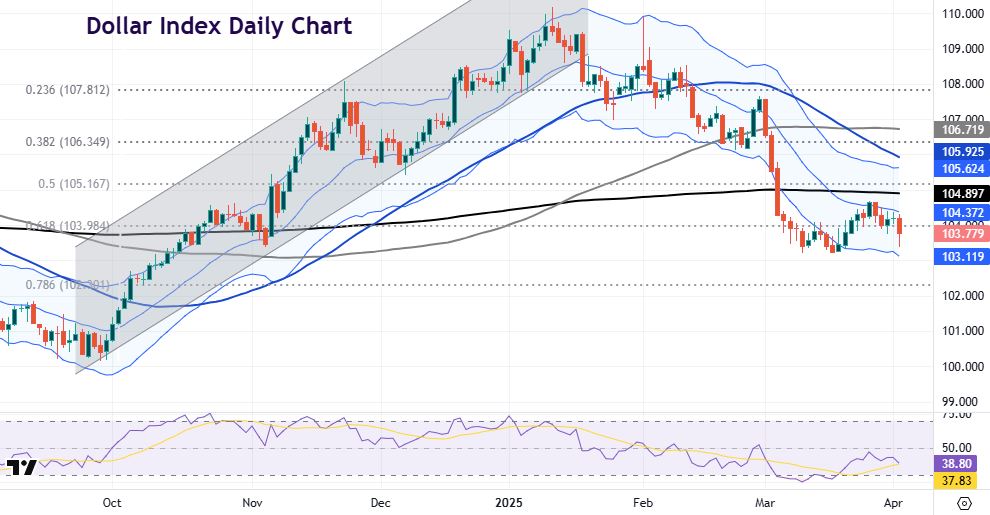Markets choppy as US hits major trading partners with tariffs

- Dollar whippy, euro pares gains on Trump tariff announcement
- Stocks closed higher on the day, but sharply lower after hours
- Trump’s 25% auto tariffs to take affect May 3rd, total China tariff now 54%
- Markets await negotiations following “Liberation Day” volley
FX: USD was unsurprisingly whippy after the Trump tariff announcement. The dollar had broadly softened ahead of the Liberation Day press conference with much speculation about what would be unveiled. Heavy tariffs which have been named for some countries have negative implications for the US economy with slower growth and higher prices across the economy affecting US consumers. The greenback was actually relatively unchanged at the time of writing, versus just before trump started speaking – 103.85 on the Dollar Index. Markets will now focus on retaliatory measures by other countries.
EUR hit a two-week high at 1.0924 before paring gains after Trump’s tariff announcement. The major was very choppy during his press conference, at one point dropping to a low at 1.0810. Prices closed higher on the day all told but then moved lower heading into Thursday’s Asian session. Tariffs of 20% are on the high side. We will be watching the EU response which comes in the early hours (0300 GMT). The European Commission said earlier it would respond in one strike to President Donald Trump’s new auto and reciprocal tariffs, on top of its answer to US steel and aluminium duties already in force.
GBP fared pretty well with just 10% tariffs. With negotiations already under way, and the EU much more in the crosshairs of Trump, the pound revelled modestly in its safe-haven status.
USD/JPY dropped near to 149 at the time of writing as the yen strengthened in the risk-off mood. The 10-year US Treasury yield sunk very close to year-to-date lows at 4.12% as bets on a near-term rate cut increased.
AUD struggled again on the general muted risk mood after ticking lower very gradually through the day.
US stocks: The S&P 500 added 0.67% to settle at 5,671. The tech-laden Nasdaq finished up 0.75% at 19,582. The Dow closed 0.56% higher at 42,225. Only two sectors were in the red – consumer staples and communication services, with consumer discretionary leading the gains, up over 2%. A media report said Elon Musk would be stepping back from his current role in DOGE in the coming weeks, but this was denied and called fake news by the White House. Telsa had leapt 5% on the news, after sliding as much as 6.4% after quarterly sales plunged 13% to the weakest in nearly three years. Amazon was said to be making a bid to buy Tiktok in the US, according to the New York Times. Futures turned sharply after the close with the ‘declaration of independence’ by Trump. They had moved higher on WSJ reports of a universal 10% tariff, but tanked deeply in the red at the start of the Asian session.
Asian stocks: Futures are negative. APAC stocks were mostly positive on Wednesday but with the major indices stuck within narrow ranges ahead of US President Trump’s ‘Liberation Day’ tariff announcement. The ASX 200 eked modest gains as strength in the real estate, tech and consumer discretionary sectors just about atoned for the losses in mining, resources and materials. The Nikkei 225 traded indecisively and wiped out most of its early gains as Japanese exporters braced for incoming US tariffs.The Hang Seng and Shanghai Comp were mixed amid tariff uncertainty with China among the countries anticipated to announce an immediate retaliation to Trump’s incoming tariffs.
Gold surged higher to another all-time top at $3,148. As we have said previously, tariff uncertainty is pushing investors into safe havens and full-on risk-off mode.
Day Ahead – “Post-Liberation Day”
After the US stock markets closed, President Trump announced baseline tariffs of 10% on all countries, higher levies on the worst offending countries, plus sectoral tariffs. Stock futures had originally moved higher on a WSJ story that there would be 10% baseline tariffs on all imports. But Trump didn’t announce this, and we saw a sharp reversal of US stock futures when he finally stated country specific rates on 60 countries. Later on, he announced universal tariffs stood at a minimum of 10%.
Notable levies include 20% on the EU, 34% on China (which is on top of the already announced 20%), 24% on Japan and 10% on the UK. Futures on risky assets moved lower, especially tech stocks, while the dollar, bonds and gold were higher. Money market bets on a June Fed rate cut rose, to around 70% from 60% before the tariffs announcement. Markets will eagerly await what negotiations and retaliations take place between countries. The dollar has edged lower again into the start of the Asian session. But stock futures are plunging and should see safe haven assets gain.
Chart of the Day – Dollar still in a downtrend
As we always emphasise in our webinar at the start of the week, the euro is by far the biggest weighting in the Dollar Index – roughly 56%. The yen and pound are next with roughly 13% and 12% respectively. Recent euro strength saw the index drop to lows at 103.19, levels last seen in November around the time of the US election. Prices moved up above a major fib level (61.8%) of the October to January rally at 103.98 but are now trading around it. Broader USD sentiment, reflected by some of the options market (the declining premium for calls over similar delta puts) is the softest since September, just before the dollar started to rally significantly. Growth risks and eroding US exceptionalism are key for USD going forward. We note Trump mentioned tax cuts very briefly in his press conference. Also Treasury Secretary Bessent tried to reassure countries after Trump spoke at the White House.

